|
||||||||||||||
Roundtrip Borneo, June 2004
Going to Sukau

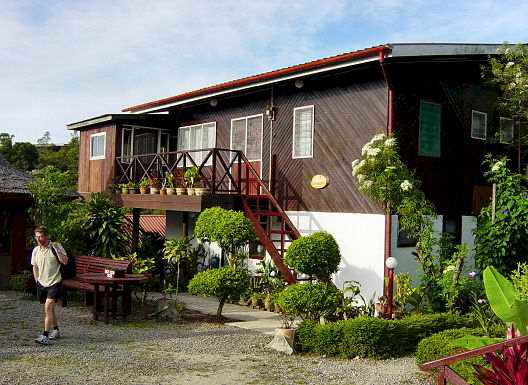
Leaving the Kinabalu Mountain Lodge
Goood morning! It is still very early morning, as we got up at 6 o'clock today. Phew, I am still feeling very sleepy. Today is going to be a travel day, so we had to pack up our suitcases again and get ready for a day on the road. Our end destination for the day Sukau!
At 7:30 we were ready to go! The minibus was waiting for us and it was time to say goodbye to the Kinabalu Mountain Lodge. I had some incredible days here, but it is time to pack up, say goodbye and get on the road again.... we have lots of new things are ahead of us!
On the road

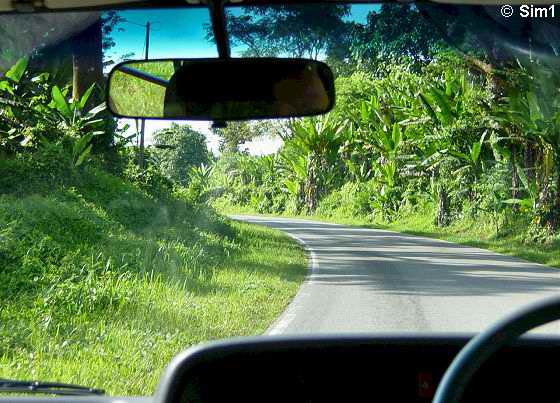
On the road to Sukau
We all got in the minivan, and off we went. We are having a long day ahead of us, with at least 4 hours of solid driving. Add to that the stops on the way, you can imagine how I felt after a day in the car. But it still was fun to look outside the window and enjoy the views. The rainforest, the little villages, the rivers, I enjoyed it all.
It's a looooong drive

Okay, I have to admit it.... after a while we all got boooored in the van. Trees... trees.... and more trees and the monotonous sound of the car engine. The landscape was still great, but from a little car window it can get a bit too much of the same thing. Instead we started doing crazy with the camera, hahaha, but I'll spare you all of those nonsense pictures ;-))
The road was rather okay though, as you can see in the picture. But especially halfway the trip there were lots of road constructions..... in other words, very BUMPY roads. But at least we gradually got exposed to those, hahaha, so we had a chance to slowly get used to them.
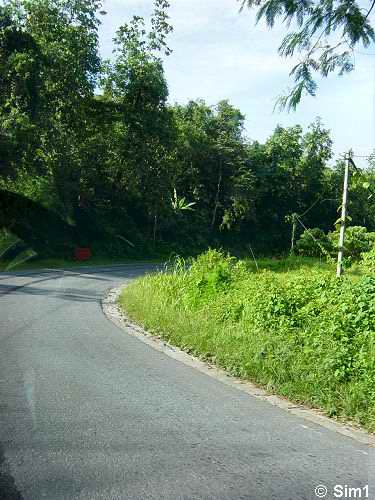
It's a looooong drive
Suspension bridge at Maputang village

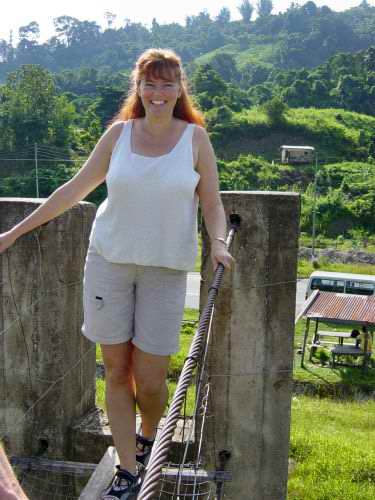
Suspension bridge at Matupang village
Aaah, finally time to get out of the car and stretch our legs! And at a fun location as well! We made a stop at the Suspension Bridge at Matupang village. The Suspension Bridge wasn't that enormously high above the river, hahaha, as you can clearly see on the smile on my face. I was just 'slightly' worried this time to walk on the bridge. This one was much better than the one at Poring Hot Spring, where I walked high above in the tree tops!
Here I am showing off my that I 'dare' to walk on the bridge :-)) The bridge crosses the river and is an important connection to a little village on the other side of the river. When we all got in the car again, I just saw some locals crossing the bridge. It was a cute sight seeing two little kids on the bridge. But unfortunately they were still too far away for me to capture them with my camera.
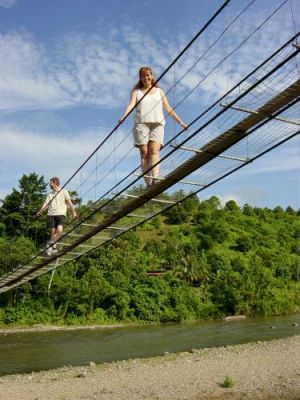
Suspension bridge at Matupang village
In the minibus again

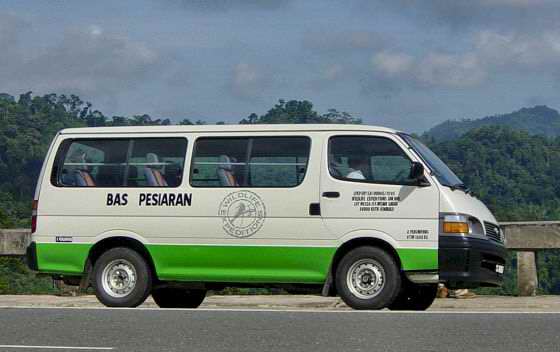
The minibus
Let's all get in the minibus again! The minibus was actually a rather comfortable way of transportation. And as we were only with a group of three (+driver and guide) we had plenty of space for ourselves and our luggage. Normally the groups are much bigger and you will have a big (normal) bus instead.
Halfway; another break to enjoy the view

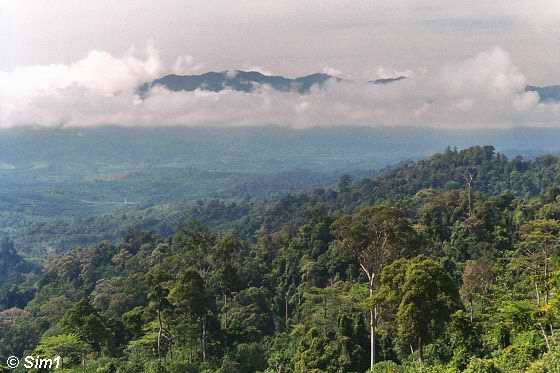
Viewpoint at Mangkadait
When we were about halfway our trip we made another stop. This time it was at Mangkadait at the border of the Sandakan division. We stopped at a bridge from where we had a great view over the surrounding landscape. It was impressive to see the vast forest, stretching out in every direction. In the distance I could see some mountain peaks stick up out of the clouds. Just a few moments here, hanging over a railing, enjoying the view. But a few moments that are in my memory for ever. Sabah is so beautiful!
Entering plantation country

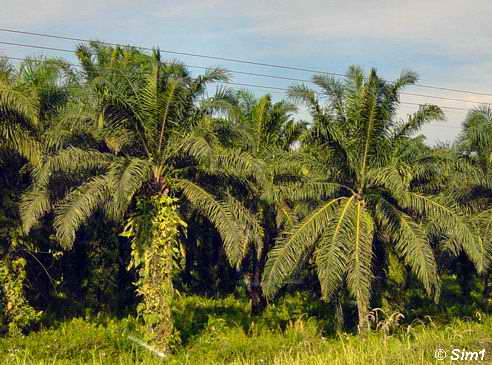
Entering plantation country
After entering the Sandakan division we seemed to have entered plantation country. You can't imagine the vastness of this area! It is plantation after plantation, the area seems to be endless! No wonder that Malaysia is the biggest producer of palm oil in the world, producing about 50% of the world's supply of palm oil.
Going to Sukau

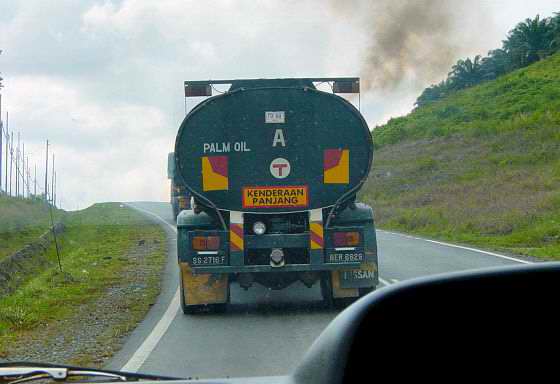
Palmoil truck
But not only on the side of the roads you will notice you are in plantation country, also when you look right in front of you, on the road itself. The road will regularly blocked by these big palm oil trucks. And as they are so heavy, they don't go so smooth uphill as you sometimes would like, slowing you down immensely. The only thing you can do is be patient, close your eyes, try not to scream and deafen your fellow passengers, and just hope your driver will overtake them with care :-))
Producing Palm Oil

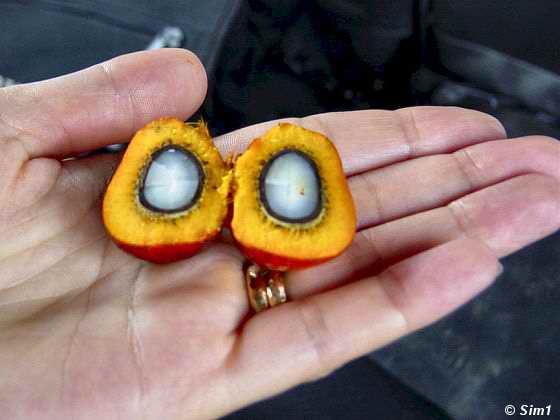
Palm oil pit
So this is the product where it is all about, the palm oil pit. From this they can make the palm oil, which is used in so many different products. The fruit is reddish, about the size of a large plum and grows in large bunches. The oil is mostly used in soap, but also in lots of food products like chocolate, margarine, biscuits, chips and muesli. The edible oil is only produced from the inside of the fruit, so that is the white part shown in the picture. Okay, I'll stop..... end of lesson.... hahaha, lunchtime now......
Roadside restaurant in Seguliud

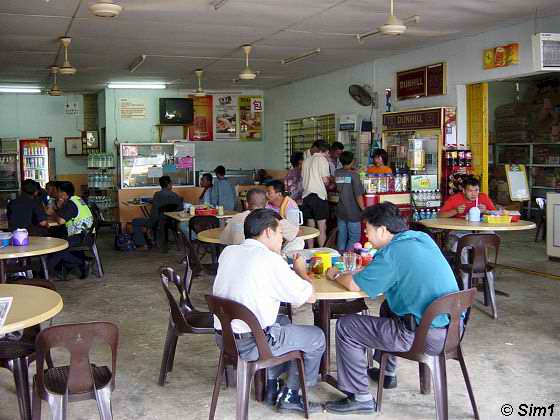
Roadside restaurant in Seguliud
Finally lunchtime! Wow, I was glad to get out of that bus for a while. We stopped at a little roadside restaurant in the village of Seguliud.
The original plan was that we should have a lunch pack with us, so we could eat somewhere along the way. But we all voted for going to a roadside restaurant, so we could eat some Malay food instead. And I didn't regret that! The restaurant was a typical small place for travellers, nothing much to look at. But the food tasted good and it was fun to try out some different dishes.
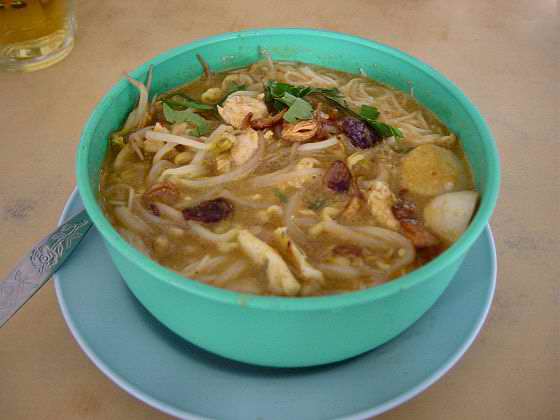
Kari Laksa
On the wall of the restaurant we could see the menu. There were 35 different dishes to choose from, hahaha, but unfortunately I had no clue what they were when reading the menu. Some I recognized again, or at least parts of it, so that gave me a bit of a clue what it would be.
With a little bit of guess work and some tips of our guide, I choose for the Kari Laksi and Åke had a Nasi Asam Pedas. The food costs next to nothing here. Each dish cost about 3,50 - 4,00 RM, that is about 0,80 Euro or 1 USD. No money at all for some good tasting food!
Lower Kinabatangan Wild Life Centre

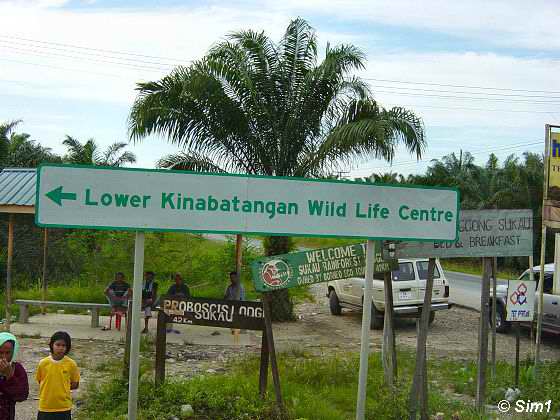
Lower Kinabatangan Wild Life Centre
After our great lunch it is time to get into the minivan again. The road continues and so do the endless rows of palm oil trees. The journey seems endless. But we finally get to the crossing for our last little bit of the trip. We turn left on an unpaved road that will bring us to the Gomantong Cave and the Lower Kinabatangan area. Our stop for the coming days.
Long dusty road

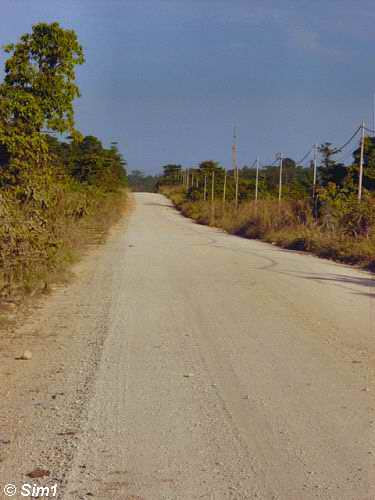
Long dusty road
But this last little bit of the journey isn't easy. We are on an unpaved road now, it is bumpy, shaky and dusty. We still have 25 kilometres to go before we get to the Gomantong caves.
After only 1 kilometre I already feel like a milkshake; this road is so bumpy! But the excitement that we are getting close to our next stop makes us forget about that. 1 more hour of 'shaking' to go and we are at the Gomantong cave!
Selamat Datang Ke Gomantong

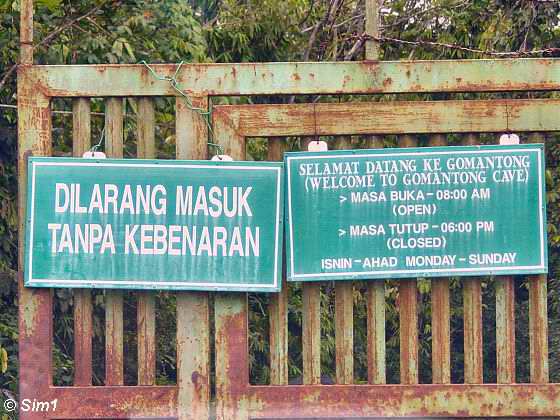
Selamat Datang Ke Gomantong
Selamat Datang Ke Gomantong / Welcome to the Gomangong Cave! We have finally arrived at the entrance gate of the Gomantong cave. The gate looks old and rusty, hahaha, not the best-looking 'welcome' to the cave. But I guess the ones that drive this far don't care about the gate, but just want to see this cave. From the gate it was another 5 kilometres on a bumpy road to get to the trail that leads to the cave.
The Gomantong cave is the largest cave system in Sabah. But the reason why it is so famous is that it is home for over one million swiftlets. A swiftlet is a type of bird and their nests are collected for the famous Chinese 'bird's nest soup'.
Camera fee

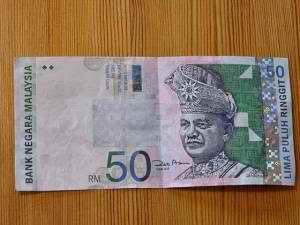
Camera fee
Unfortunately it is not allowed to take pictures in and around the cave without paying a camera fee. For a normal camera we had to pay 30 Malaysian Ringgit, which is about 8 USD or 6,50 Euro. A bit too much we thought, Especially considering that it would be hard to take pictures inside the dark cave anyway.
So unfortunately I can't show you any pictures of the cave and of its various 'inhabitants'. But instead I'll try to paint you a picture with words in the next few tips. Hahaha, I have a feeling that is going to be impressive enough, as some of these 'cave-inhabitants' are rather creepy ;-))
Going to Sukau

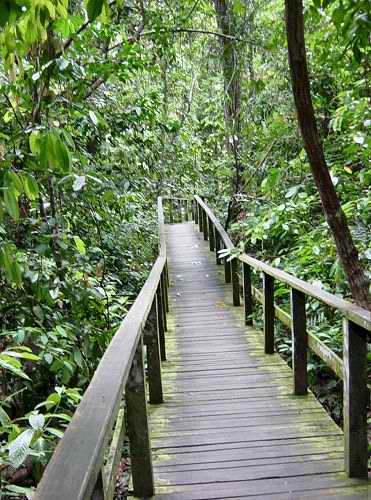
Walkway to the Gomantong Caves
At the parking lot we changed into more appropriate clothes for the caves: long pants, long sleeved shirts and a hat to protect my head. The bottom of my pants were nicely secured by being tugged into my socks..... I had heard about the many creepy crawlers in this cave, and I didn't want to give any of those an opportunity to crawl up my leg! Eeeeeks!
All of these precautions are really necessary to 'survive' this cave without screaming out loud all the time, LOL. The reason for all this is the risk of droppings from the many bats and swiftlets in the cave and of course the threat from ALL sides of the creepy crawlers.
But first of all we need to walk to the cave. The hike is easy as the whole trail is over this boardwalk. It was boiling hot though in the rainforest and the tropical moist heat was hard to bear. When you walk here do keep your eyes open! If you are looking you might spot monkeys in the trees!
The closer you get to the cave, the clearer the smell gets. The odour of bird and bat shit is very distinct. No doubt about it where you are going.... the smell says it all!
Gomantong Cave

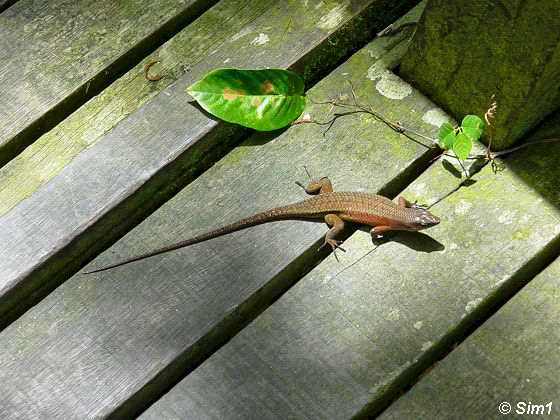
Walkway to the Gomantong Caves
The cave is a totally 'different' experience, absolutely not something for the faint-hearted. It is dark inside the cave and it is hard to orientate where you are and what's actually in the cave, when you go in....
High above you circle thousands, maybe millions of bats and swiftlets. Most of the swiftlets are out for the day and the bats are sleeping. But at dusk and dawn it must be a spectacular sight to see them enter and leave the cave, as there are millions of them living here.
When you get used to the dark you will be able to spot the swiftlets and the bats. The smell is almost unbearable. But all that for me was not the worst...... The boardwalk was slippery from all the bat- and bird sh!t.... and with every step I took I could see hundreds of cockroaches flee away from my feet. And I am not kidding if I say they are HUGE! And sooo many.... arghhhh.... I was trembling on my feet! The boardwalk was covered with them, I could hardly see the floor because of these cockroaches. But as soon as I moved my feet they all fled to the sides..... and to my relief they did that with every step I took ;-))
There was a railing on the side of the board walk, so you had something to hold on to. Quite a nice idea, as it was so slippery in here and I was rather afraid of falling down. But eehhhh..... again, hundreds of those huge cockroaches called these railings there 'home'. Not something I would like to put my bear hands onto... eeeeeks!
No I did not scream, even if my heart was pounding hard, and all I could think was: 'Why am I doing this!!!!!???'.
What can I say, besides that this is a totally 'different' experience :-)) Would I do it again.... hahaha, probably not. But I am glad I did it once in my life, just to prove that I could, but I think I don't need another one of these 'creepy crawler' experiences.
Bring a torch!

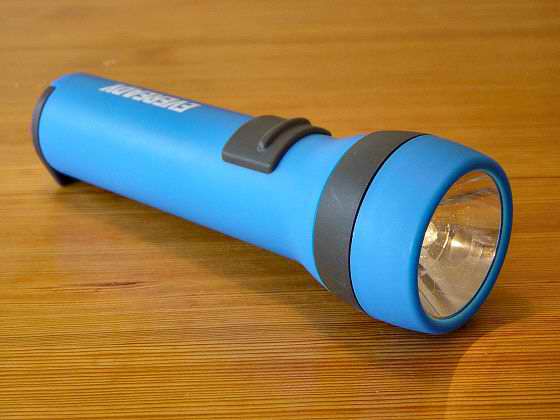
Bring a torch!
You absolutely need a good torch when you go inside the cave. It is pitch dark in there and as you probably understood of my previous tip, it is quite nice to see where you are walking. The walls, the board walk, the railing are covered with huge cockroaches. Oh yes, and if you are interested, you can spot some other creepy insects on the walls of the cave as well! The trail follows those walls, so you have lots of opportunities to have a look! ;-)) I can't remember the exact name, but I can recall being highly impressed by seeing a huge poisonous bird-eating centipedes and spiders...... eekss..... can we continue our walk now.... I want to get out of this cave!!!! :-))
Nope, not yet! Hahaha, we have to see 'why' we are in this cave first! It is time to look up! Looking up is interesting as you can see those thousands of bats and swiftlets. Besides that you can see the constructions the local people use to harvest the birds nests. The cave is so high, it is hard to believe they can climb up there just using ladders, ropes and poles. The birds nest are used for the famous Chinese 'bird's nest soup'. And these birds nests is what makes this cave so unique.
How interesting it may be to look up, I have to warn you for doing that at the same time! The swiftlets and bats don't care where they drop there sh!t, and if you don't watch it, it might be on your head. As you can see I am torn between disgust and amazement by this cave. Hahaha, but I 'survived' and I am happy to have dared to have unique and most likely 'one time' experience :-))
Artificial cave

Still full with impressions of the Gomantong Caves we are on our way again, our destination is not for away anymore, we are getting close to Sukau.
During our ride we saw this artificial cave. I know, I know, it is a very bad picture. But it isn't easy to take photos out of a minivan, while being tossed around like a milkshake because of the bumpy road :-)) But it was interesting to see this artificial cave, so that's why I decided to post the picture anyway.
The Gomantong Caves are protected and it is only allowed to harvest the nests of the swiftlets twice a year. The birds nests are worth a lot of money though, and that's why they started this artificial cave.
There are four species of swiftlets that build their nests on the wall of the cave. But there are only two of types that are edible. The "black " nests are less valuable and they consist of hardened saliva mixed with feathers. The other type of nests are the "white " nests, which are made of pure saliva These 'white' nests can fetch more than US$ 500 per kilogram.
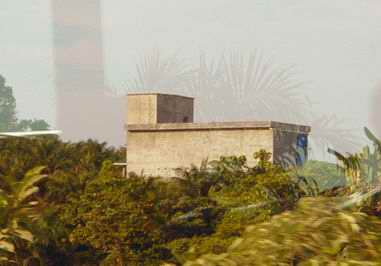
Artificial cave
Trucks in the middle of the road

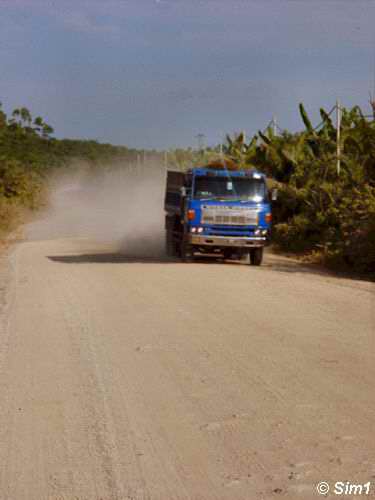
Trucks in the middle of the road
The journey continues. Palm trees on the left side of the road, palm trees on the right side of the road and a steady traffic of heavy trucks coming our way. There are quite a few of those trucks on this road because they transport the fruits of the palm trees to the factory.
The road is not comfortable, bumpy, shaky. And our driver is trying to make the best of it trying to find the best track on this dusty bumpy road. So that means that we drive sometimes on the left side, sometimes on the right side and sometimes we simply claim the middle of the road :-)) Nothing to worry about.... until you meet those big heavy trucks! And.... eeeeeks! They do exactly the same!!!
Neither is willing to move their vehicle to their 'own' side of the road.. until the very last moment of course! Those trucks really do look BIG when they get closer and closer in front of your nose! But luckily on the very last minute the drivers give in and get back to their own half of the road and we pass each other in a huge cloud of dust..... phew, one more truck less to worry about ;-)
Water Buffalo

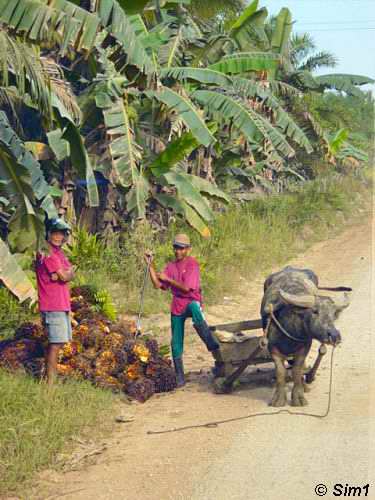
Water Buffalo
Quite a contrast to those modern trucks was seeing this water buffalo. They use them to get the harvest from the fields to the side of the road.
The last bit of the journey was quite nice, looking out of the window, seeing a bit of the local life. Sometimes we passed some people and some houses, and of course those endless plantations on both sides of the road
White Egret

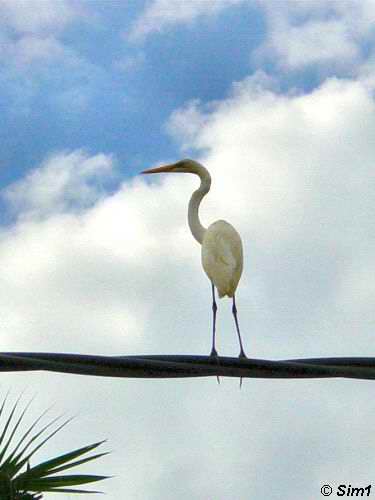
White Egret
We spotted this White Egret while driving on the bumpy road. The driver was so nice and made a quick stop we could make a picture of it. I remember being so enthusiastic and feeling happy of seeing a beautiful bird like this on the side of the road. Fantastic! But how little I knew what would be waiting for us the next day. Hahaha, I have to admit that I stopped counting that day after having seen over a dozen of White Egret. But I think I will remember this one best, because it was the first :-)
Arriving at Sukau

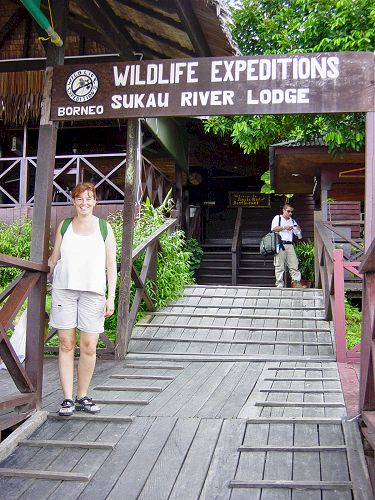
Arriving at Sukau
We are here! Our end destination of the day, the Sukau River Lodge. The last little bit of the journey was a little boat trip to get to the lodge, which is located on the river. A beautiful spot to be!
It is time to unpack my suitcase and relax a bit. Tomorrow it is going to be early day again and without a doubt I will have lots to tell you again. But for now it is goodbye, find a lazy chair, and do nothing but enjoy the views. I hope to see you again on the next page of my journey! :-))
The trip continues...

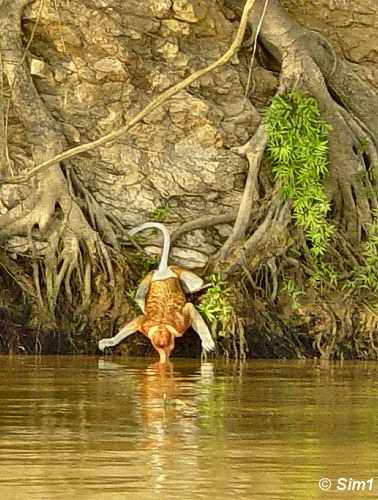
Nose monkey at Sukau
My long day of travelling has come to an end. But it was great to see a bit of the country, learn about the palm oil plantation and visit the Gomantong caves.
The previous leg of my journey was a visit to Poring Hot Spring, famous for its hot springs. But I enjoyed the Canopy Walkway by for the most. It was a great experience to walk high up in the treetops of the rainforest.
My next page will be about Sukau, my favourite part of the journey. I stayed here for two days and I wouldn't have minded staying here longer. I hiked, did tours on the river, saw lots of birds and had an amazing encounter with a nose-monkey.
I hope you will join me on this virtual trip and enjoy reading my travel stories and see the pictures. For me it has been fantastic to write about my journey because it has made me relive the trip once again :-)